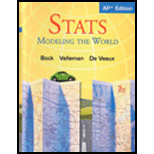
(a)
To describe the W’s for these data: who, what, where, why, when and how.
(a)
Explanation of Solution
It is given in the question that the researchers want to study is it a good idea to listen to music when studying for a big test. In a study conducted by some statistics students people were randomly assigned to listen to rap music or no music while attempting to memorize objects pictured on a page. They were then asked to list all the objects they could remember. The five-number summary is given. Thus, the W’s for these data are:
Who:
What: Music listed to objects remembered.
Where: Not stated.
Why: To see if music helps while studying for tests and if so, what kind?
When: Not stated.
How: Study done by statistics students.
(b)
To name the variables and classify each as categorical or quantitative.
(b)
Answer to Problem 26RE
The variables of the study are: music listened to and objects remembered.
Explanation of Solution
It is given in the question that the researchers want to study is it a good idea to listen to music when studying for a big test. In a study conducted by some statistics students people were randomly assigned to listen to rap music or no music while attempting to memorize objects pictured on a page. They were then asked to list all the objects they could remember. The five-number summary is given. Thus, the variables of the study are: music listened to and objects remembered. The variable music listened to is a categorical variable and the variable objects remembered is a quantitative variable.
(c)
To create parallel boxplots as best you can from these summary statistics to display these results.
(c)
Answer to Problem 26RE
Explanation of Solution
It is given in the question that the researchers want to study is it a good idea to listen to music when studying for a big test. In a study conducted by some statistics students people were randomly assigned to listen to rap music or no music while attempting to memorize objects pictured on a page. They were then asked to list all the objects they could remember. The five-number summary is given. Thus, parallel boxplots as best we can create from these summary statistics to display these results are as:



(d)
To write a few sentences comparing the performance of the three groups.
(d)
Explanation of Solution
It is given in the question that the researchers want to study is it a good idea to listen to music when studying for a big test. In a study conducted by some statistics students people were randomly assigned to listen to rap music or no music while attempting to memorize objects pictured on a page. They were then asked to list all the objects they could remember. The five-number summary is given. Thus, we can say that Rap and Mozart had roughly the same outcome, having at least one person that responded very well to the music. Among the people that did not listen to music they had better average scores all the way around but had a lower maximum score. This shows that certain students do very well certain kinds of music but if the music foes not help their focus a person is better off without music.
Chapter PI Solutions
Stats: Modeling the World Nasta Edition Grades 9-12
Additional Math Textbook Solutions
Statistical Reasoning for Everyday Life (5th Edition)
An Introduction to Mathematical Statistics and Its Applications (6th Edition)
Basic Business Statistics, Student Value Edition
Introductory Statistics (2nd Edition)
Fundamentals of Statistics (5th Edition)
Essentials of Statistics, Books a la Carte Edition (5th Edition)
 MATLAB: An Introduction with ApplicationsStatisticsISBN:9781119256830Author:Amos GilatPublisher:John Wiley & Sons Inc
MATLAB: An Introduction with ApplicationsStatisticsISBN:9781119256830Author:Amos GilatPublisher:John Wiley & Sons Inc Probability and Statistics for Engineering and th...StatisticsISBN:9781305251809Author:Jay L. DevorePublisher:Cengage Learning
Probability and Statistics for Engineering and th...StatisticsISBN:9781305251809Author:Jay L. DevorePublisher:Cengage Learning Statistics for The Behavioral Sciences (MindTap C...StatisticsISBN:9781305504912Author:Frederick J Gravetter, Larry B. WallnauPublisher:Cengage Learning
Statistics for The Behavioral Sciences (MindTap C...StatisticsISBN:9781305504912Author:Frederick J Gravetter, Larry B. WallnauPublisher:Cengage Learning Elementary Statistics: Picturing the World (7th E...StatisticsISBN:9780134683416Author:Ron Larson, Betsy FarberPublisher:PEARSON
Elementary Statistics: Picturing the World (7th E...StatisticsISBN:9780134683416Author:Ron Larson, Betsy FarberPublisher:PEARSON The Basic Practice of StatisticsStatisticsISBN:9781319042578Author:David S. Moore, William I. Notz, Michael A. FlignerPublisher:W. H. Freeman
The Basic Practice of StatisticsStatisticsISBN:9781319042578Author:David S. Moore, William I. Notz, Michael A. FlignerPublisher:W. H. Freeman Introduction to the Practice of StatisticsStatisticsISBN:9781319013387Author:David S. Moore, George P. McCabe, Bruce A. CraigPublisher:W. H. Freeman
Introduction to the Practice of StatisticsStatisticsISBN:9781319013387Author:David S. Moore, George P. McCabe, Bruce A. CraigPublisher:W. H. Freeman





